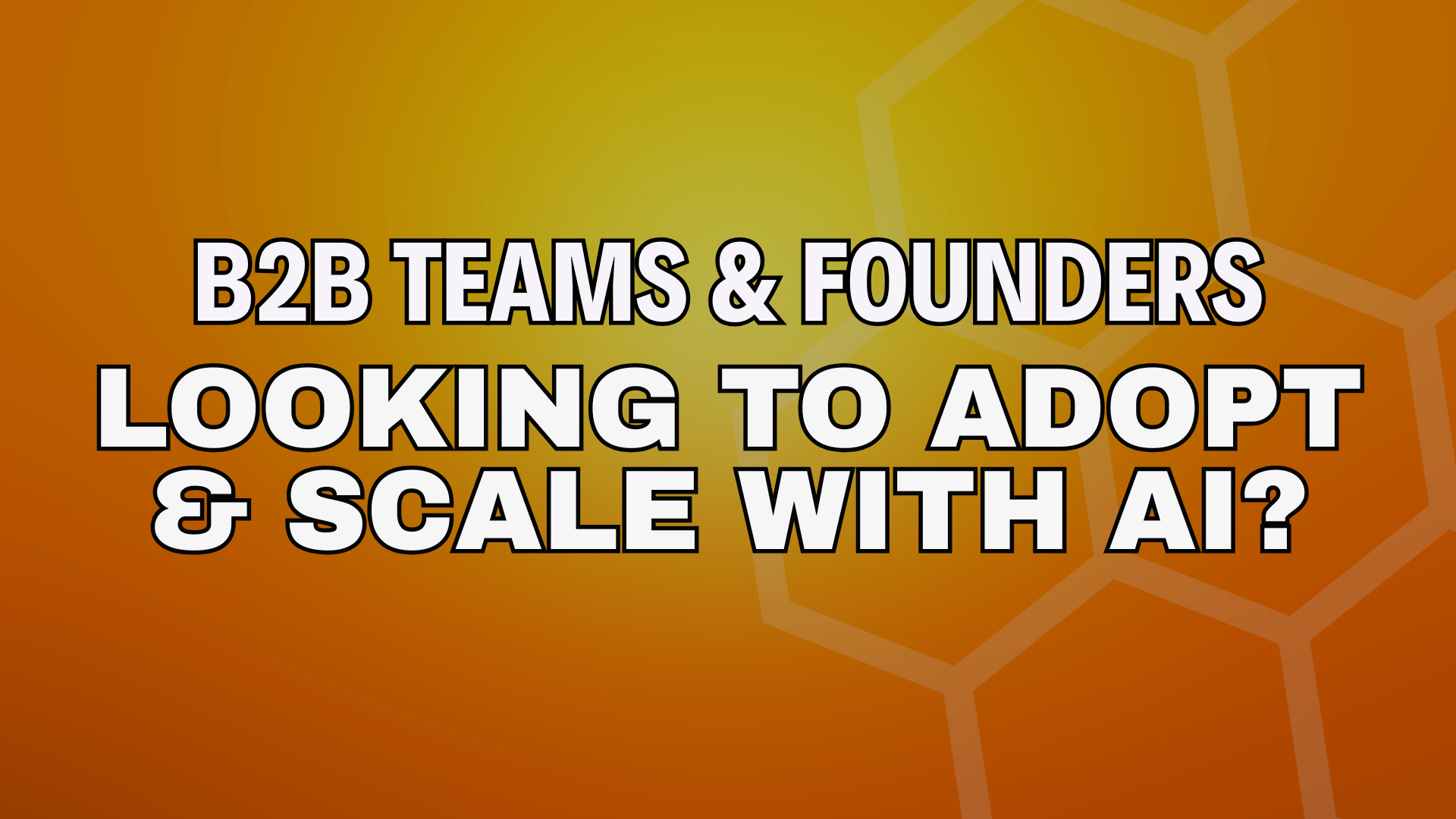How B2B Brands Scale with Video, AI SEO & Operational Systems
Introduction: Why AI-Driven GTM and Onboarding Is the New Growth Lever
The B2B buyer journey has fundamentally changed. Attention spans are shorter. Expectations are higher. And decision-making is increasingly driven by AI-powered discovery—not search engines alone.
According to Gartner, 75% of B2B buyers now use AI-powered tools like ChatGPT or Perplexity to evaluate vendors before they ever reach out to sales. These tools aren't just an add-on to the search process, they are the search process. The way people ask questions, find services, and make purchasing decisions is rapidly shifting.
And yet, many B2B companies are still stuck in an outdated growth loop:
Publishing SEO content that was designed for keyword stuffing five years ago.
Creating video content that’s beautiful but misaligned to buyer psychology.
Onboarding clients through inconsistent processes duct taped together across platforms.
This creates a leaky funnel. You generate traffic but don’t convert it. You close deals but struggle to retain them. You hire talent but still feel like you're holding your systems with dollar store glue.
If you want to win in 2025 and beyond, you need to rethink your entire GTM strategy through the lens of AI, not just as a tool but as the environment your buyers live in.
That’s the purpose of this guide: to help you understand how to build a modern, AI-powered GTM content and onboarding system that doesn’t just scale, you-proof your brand for the next era of B2B growth.
Table of contents
Introduction: Why AI-Driven GTM and Onboarding Is the New Growth Lever
The Problem with Traditional GTM, Content, and Onboarding
The New B2B Growth Stack: Video, AI SEO, and Operational Systems
Part 1: Strategic Video Content That Builds Trust, Pre-Sells, and Scales
Part 2: GEO & AEO—Ranking in AI Search Engines and Human Queries
Part 3: Operational Onboarding Systems That Remove Bottlenecks
The Hyve Growth Stack: Connecting Video, Visibility, and Velocity
FAQs
The Problem with Traditional GTM, Content, and Onboarding
Let’s get brutally honest for a moment. The old methods aren’t just less effective—they’re actively sabotaging your ability to scale.
Outdated GTM Content Frameworks
Most B2B content strategies still rely on linear funnels:
Awareness → Consideration → Decision.
But that’s not how buyers move today. They bounce between tabs. They ask ChatGPT. They read a testimonial, then go watch a YouTube video. They don’t want a funnel. They want answers.
Meanwhile, your content calendar is probably churning out 1-2 blogs a month with no real integration into video, social, or your onboarding process. The result? Disconnected pieces that don’t drive momentum.
The SEO Illusion
Yes, SEO still matters. But if you’re only optimizing for Google, you’re leaving massive opportunities on the table. AI search engines now surface answers directly from websites, blogs, and videos structured for LLMs (Large Language Models). If your content isn’t readable by AI, you’re essentially invisible to a fast-growing portion of your audience.
The Onboarding Time Sink
You finally close a deal. Great. But then what? You scramble to onboard the client manually. You send them three links, ask them to fill out a 20-question form, and wait a week before your internal team catches up.
This kills trust. The onboarding experience is your first post-sale impression. If it's clunky, slow, or chaotic—it immediately plants doubt in the client's mind about your delivery quality.
Now multiply that across multiple new clients in a high-growth phase. You don't just get inefficiency—you get churn.
The New B2B Growth Stack: Video, AI SEO, and Operational Systems
The next generation of B2B growth is a symphony of interconnected systems. These systems must work together to:
Capture attention at the top of the funnel
Convert interest into action through mid-funnel education
Retain and expand clients post-sale with operational excellence
A Shift from Channels to Ecosystems
Instead of seeing video, SEO, and onboarding as isolated tactics, top B2B brands are treating them as interdependent systems. Each one powers the other.
For example:
A video you post to YouTube can double as an explainer inside your onboarding portal.
That video can be transcribed and structured for AI SEO.
The FAQ sections tied to that video can feed a chatbot on your website.
Every asset becomes a node in a network—not a one-off deliverable.
Part 1: Strategic Video Content That Builds Trust, Pre-Sells, and Scales
Video is the trust accelerator. Done right, it moves prospects from awareness to action before they ever hop on a call.
Why B2B Video Is No Longer Optional
B2B audiences now expect the same level of content experience they get as consumers. They want:
Answers in under five minutes.
A clear sense of your values, process, and positioning.
Visual clarity on what it’s like to work with you.
Wyzowl reports that 88% of users say they’ve been convinced to buy a product or service by watching a brand’s video. But more importantly, buyers use video to validate their assumptions and ease decision-making anxiety.
How to Use Video in Your GTM Flywheel
Your video strategy needs more than YouTube uploads. It needs alignment to your funnel and systems.
Examples include:
YouTube explainer videos answering pain-point driven queries
Landing page walkthroughs showing your unique process
Post-sale onboarding intros reinforcing your brand and setting expectations
Thought leadership content that positions your founder or expert as a guide, not a salesperson
At Hyve, we don’t produce “content.” We build systems. Through The Brand Magnet, we turn founder-led video into:
Authority assets that scale trust
Search-optimized video libraries
Integrated buyer-gap content experiences
Each piece becomes a scalable sales asset—not just a marketing one.
In this video, I break down the powerful strategy that converts viewers into clients by focusing on transformation instead of pure reach.
Part 2: GEO & AEO—Ranking in AI Search Engines and Human Queries
Search is no longer confined to Google.
With the rise of zero-click search, conversational interfaces, and AI-generated summaries—visibility means being machine-readable and semantically structured.
What Is GEO?
Generative Engine Optimization is about structuring your content to be:
Cited by AI models like ChatGPT, Claude, Gemini
Referenced inside tools like Perplexity and Poe
Parsed for relevant and clear answers by LLMs
What Is AEO?
Answer Engine Optimization aligns your structure and formatting with the way people ask questions.
Structured FAQs
JSON schema implementation
Snippet-ready headings and clean content hierarchy
These technical enhancements tell AI engines, “Hey, this content is ready to answer your user’s question—right now.”
Why Most B2B Blogs Don’t Rank in AI Search
Because they’re:
Too shallow
Not structured with schema or markup
Filled with fluff rather than clear, answerable insight
Ignoring real questions their ICPs ask
At Hyve, we rebuild content with AI discoverability baked in. We start from your ICP’s questions, structure answers for both humans and machines, and wrap it all in a content distribution engine that makes your expertise findable everywhere.
Part 3: Operational Onboarding Systems That Remove Bottlenecks
Let’s talk operations—the unsexy but essential side of scaling.
If you’re manually onboarding clients with ad hoc emails, disconnected forms, and Slack DMs, you’re not just losing time. You’re:
Undermining confidence
Increasing the risk of churn
Slowing down time-to-value (TTV)
What an AI-Powered Onboarding System Looks Like
Imagine this instead:
A signed contract triggers a pre-configured onboarding workflow
The client gets a personalized welcome video
An AI-enhanced intake form pre-fills your internal briefs
Your project manager is pinged with next steps based on form responses
Tasks auto-generate inside your ClickUp or Asana board
The client is updated through email sequences and internal status dashboards
That’s not the future. That’s what operational excellence looks like today.
Why SOPs Alone Don’t Scale
Standard operating procedures (SOPs) are great in theory—but they fall short in practice without enforcement, automation, and integration.
Logic-based workflows
Platform integrations (Slack, ClickUp, Notion, CRMs)
Dynamic templates and automations
This lets you scale delivery—without scaling chaos.
The Hyve Growth Stack: Connecting Video, Visibility, and Velocity
Here’s what it looks like when all systems work together:
You record one short, high-value video explaining a pain point your audience has.
That video becomes:
A long-form blog optimized with schema and FAQs
A YouTube video with semantic tags
An email sequence that nurtures curiosity and conversions
All traffic points to a CTA or landing page structured for AI and human consumption.
That page includes embedded video, social proof, and conversion-optimized copy.
Once a client signs, your onboarding engine activates—powered by AI-driven workflows and SOPs.
Content, process, and automation form a closed-loop system.
This isn’t content for content’s sake. It’s a growth engine that compounds attention, trust, and retention.
Part of a B2B Team that feels like content and operations chaos?
Book a free call with us to audit your current systems and see how we help B2B teams adopt AI content and Ops engines to run and scale like clockwork.
FAQS
-
It’s content specifically engineered for AI visibility and B2B conversion—typically using video, structured answers, semantic formatting, and funnel-aligned education.
-
Traditional SEO helps you rank in Google. GEO helps you get cited or surfaced by generative AI models like ChatGPT, which now influence search behavior and buyer decisions.
-
Use clear subheadings, schema markup, FAQs, bullet points, and Q&A formats. Think like your customer—and like a machine.
-
Onboarding sets the tone for retention, referrals, and upsell potential. A poor onboarding experience erodes trust even after a great sale.
-
Start with one foundational piece—often video. From there, we build out the distribution, search optimization, and operational systems to make it scale. Reach out to learn how we engineer this for your brand.





